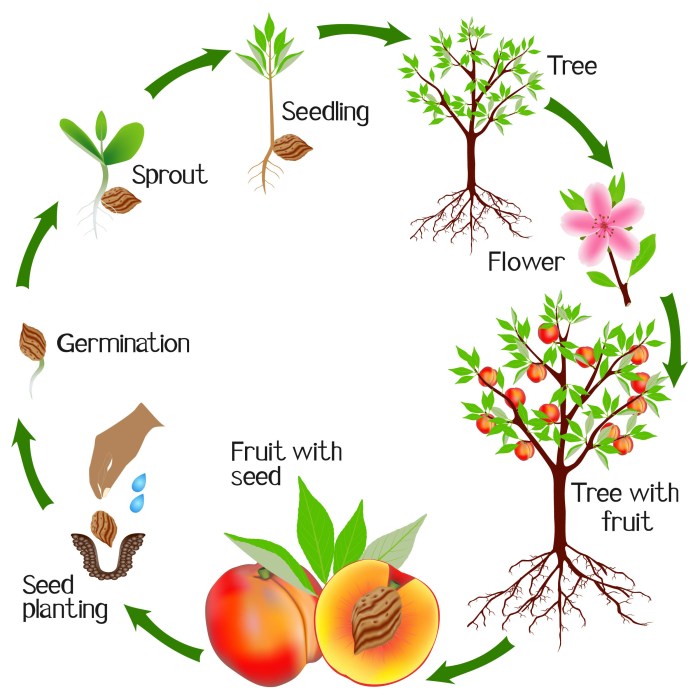How a Plant Grows From a Seed
Seed Germination
How a plant grows from a seed – Seed germination is the process by which a seed develops into a seedling. This intricate process involves a series of carefully orchestrated events, beginning with imbibition and culminating in the emergence of the radicle and plumule. Understanding these stages is crucial to appreciating the remarkable journey from seed to plant.
Seed Imbibition and its Importance
Imbibition is the initial step in germination, where the seed absorbs water. This water uptake is crucial for several reasons. It activates enzymes necessary for metabolic processes, softens the seed coat to facilitate its rupture, and initiates the expansion of the embryo, ultimately leading to the emergence of the radicle (embryonic root) and plumule (embryonic shoot).
The Role of the Seed Coat in Germination
The seed coat, or testa, plays a vital protective role. It safeguards the embryo from physical damage, desiccation, and microbial attack. However, for germination to occur, the seed coat must become permeable to water and gases. This permeability can be achieved through various mechanisms, including weakening of the coat through enzymatic action or natural wear and tear.
Radicle and Plumule Emergence
The radicle, the embryonic root, is the first structure to emerge from the germinating seed. It anchors the seedling and begins absorbing water and nutrients from the soil. Following the radicle, the plumule, the embryonic shoot, emerges, developing into the stem and leaves. The direction of growth for both is influenced by gravity (geotropism) and light (phototropism).
Comparison of Monocot and Dicot Germination
Monocots and dicots, the two major groups of flowering plants, exhibit distinct germination patterns. The following table highlights key differences.
| Characteristic | Monocots | Dicots | Notes |
|---|---|---|---|
| Cotyledon Number | One | Two | Cotyledons are embryonic leaves that provide nutrients to the seedling. |
| Seedling Emergence | Coleoptile emerges first, protecting the plumule | Plumule emerges directly | The coleoptile is a protective sheath in monocots. |
| Root System | Fibrous root system | Taproot system | Different root systems affect water and nutrient uptake. |
| Energy Storage | Endosperm | Cotyledons | Endosperm is a nutritive tissue surrounding the embryo in monocots. |
Root Development: How A Plant Grows From A Seed
The root system, crucial for anchorage and nutrient uptake, undergoes significant development following germination. The primary root and its subsequent branches, the lateral roots, work in concert to fulfill these vital functions.
Functions of Primary and Lateral Roots
The primary root, originating from the radicle, establishes the initial root system. Lateral roots branch from the primary root, increasing the surface area for absorption of water and minerals from the soil. This extensive network ensures efficient uptake of resources crucial for plant growth.
Taproot and Fibrous Root Systems
Two main types of root systems exist: taproot and fibrous. Taproot systems feature a prominent central root (the taproot) with smaller lateral roots branching off. This system is common in dicots and provides deep anchorage and efficient water access. Fibrous root systems, characteristic of monocots, consist of numerous thin roots spreading horizontally near the soil surface. This system excels at preventing soil erosion and rapid water absorption.
Root Hair Formation and Water Absorption
A detailed illustration would show numerous root hairs extending from the epidermis of the root. These tiny, hair-like projections greatly increase the surface area for water and nutrient absorption. Water is absorbed through osmosis, driven by the concentration gradient between the soil solution and the root cells. Minerals are absorbed through active transport, requiring energy expenditure by the root cells.
Root Adaptations for Nutrient Uptake and Water Storage
Various root adaptations enhance nutrient uptake and water storage. For example, some plants develop mycorrhizal associations with fungi, which enhance nutrient absorption. Other plants, such as carrots and beets, have specialized roots for storing water and nutrients.
Shoot Development
The emergence of the shoot marks a significant transition in the seedling’s life cycle, initiating its journey towards photosynthesis and independent growth. The cotyledons play a critical role in this transition.
Shoot Emergence and the Role of Cotyledons
The shoot emerges from the seed, initially protected by a sheath (coleoptile in monocots). Cotyledons, the embryonic leaves, provide the seedling with essential nutrients until its true leaves develop and begin photosynthesis. Once the true leaves are functional, the cotyledons typically wither and fall off.
Stages of Shoot Growth and Leaf Development
Shoot development involves several stages: initial emergence, stem elongation, leaf formation, and branching. Leaf development begins with the formation of leaf primordia (rudimentary leaves) at the shoot apex (tip). These primordia then develop into mature leaves, exhibiting characteristic shapes and sizes depending on the plant species.
The journey of a plant begins with a tiny seed, containing all the genetic information needed for growth. To start your own gardening adventure, you’ll first need seeds, and you might wonder, ” does Walmart sell plant seeds ?” Once you’ve acquired your seeds, proper planting and care, including sunlight and water, are essential for successful germination and the emergence of a seedling, eventually leading to a mature plant.
Sequence of Events from Seed to Seedling
The following list summarizes the key events in the transition from seed to seedling:
- Imbibition of water
- Activation of enzymes
- Radicle emergence
- Root development
- Plumule emergence
- Shoot development
- Cotyledon expansion (if present)
- True leaf development
- Photosynthesis initiation
Photosynthesis and Growth
Photosynthesis, the process by which plants convert light energy into chemical energy, is fundamental to plant growth. This process, coupled with nutrient uptake from the soil, fuels the plant’s development and overall health.
Photosynthesis and its Importance
During photosynthesis, plants utilize sunlight, water, and carbon dioxide to produce glucose (a sugar) and oxygen. Glucose serves as the primary source of energy and building blocks for plant growth. Oxygen is released as a byproduct.
Nutrient Uptake from the Soil
Plants absorb essential nutrients from the soil through their roots. These nutrients, including nitrogen, phosphorus, and potassium, are crucial for various metabolic processes, including enzyme activity and protein synthesis. Nutrient deficiencies can significantly impair plant growth.
Role of Sunlight, Water, and Carbon Dioxide

Source: co.uk
Sunlight provides the energy for photosynthesis. Water is a reactant in photosynthesis and also essential for maintaining turgor pressure (cell firmness). Carbon dioxide is another reactant in photosynthesis, providing the carbon atoms for glucose synthesis.
Growth Rates of Different Plant Species
Plant growth rates vary considerably among species. Fast-growing plants, such as sunflowers and some grasses, exhibit rapid stem elongation and leaf production. Slower-growing plants, such as many trees, have a more gradual growth pattern.
Environmental Factors
Environmental factors significantly influence plant growth and development. Light intensity, temperature, water availability, and soil composition all play crucial roles.
Impact of Light Intensity
Light intensity affects the rate of photosynthesis. Sufficient light is essential for optimal growth, while excessive light can damage plant tissues. Shade-tolerant plants are adapted to low light conditions, while sun-loving plants thrive in high light environments.
Effects of Temperature
Temperature affects enzyme activity and metabolic rates. Optimal temperature ranges vary among plant species. Extreme temperatures can inhibit germination and growth, leading to stress and potential damage.
Role of Water Availability
Water is essential for photosynthesis, nutrient transport, and maintaining cell turgor. Water stress, caused by insufficient water availability, can severely restrict plant growth and lead to wilting and death.
Soil Composition and Root Growth
Soil composition, including texture, structure, and nutrient content, significantly influences root growth. Well-drained soils with appropriate nutrient levels promote healthy root development, while compacted or nutrient-poor soils can hinder root growth and limit nutrient uptake.
Plant Hormones
Plant hormones, or phytohormones, are chemical messengers that regulate various aspects of plant growth and development. Auxins, gibberellins, cytokinins, abscisic acid, and ethylene are key players in this intricate regulatory system.
Role of Auxins, How a plant grows from a seed
Auxins stimulate cell elongation and differentiation, influencing stem growth and apical dominance (the dominance of the main stem over lateral branches). They also play a role in root development and fruit formation.
Functions of Gibberellins
Gibberellins promote seed germination, stem elongation, and flowering. They break seed dormancy and stimulate enzyme production involved in mobilizing stored nutrients.
Impact of Cytokinins

Source: tinasdynamichomeschoolplus.com
Cytokinins stimulate cell division and differentiation, promoting shoot and root growth. They also delay leaf senescence (aging) and influence apical dominance.
Abscisic Acid and Ethylene Effects
Abscisic acid (ABA) generally inhibits growth, promoting seed dormancy and stress tolerance. Ethylene promotes fruit ripening, leaf abscission (shedding), and senescence. While both can inhibit growth under certain conditions, they play distinct roles in plant development.
Commonly Asked Questions
What is the difference between monocot and dicot seeds?
Monocots have one cotyledon (seed leaf), while dicots have two. This difference affects their germination patterns and overall plant structure.
How long does it take for a seed to germinate?
Germination time varies greatly depending on the plant species, seed viability, and environmental conditions. It can range from a few days to several weeks or even months.
Can I use any type of soil for planting seeds?
No, different plants have different soil requirements. Well-draining soil rich in organic matter is generally ideal for most seeds. Poorly draining soil can lead to root rot.
What happens if a seed doesn’t germinate?
Several factors can prevent germination, including poor seed viability, unfavorable environmental conditions (temperature, moisture, light), or pest/disease damage.





















